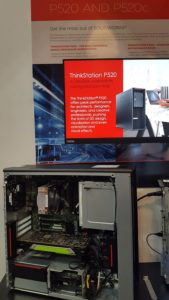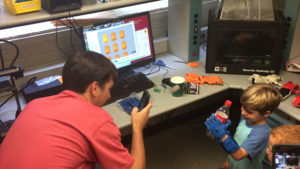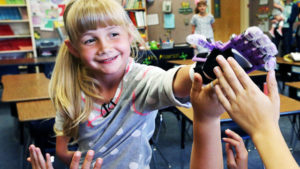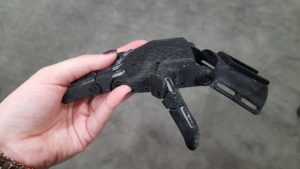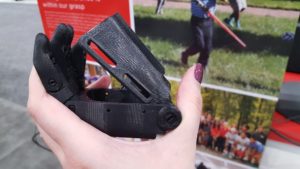 Multinational corporation Lenovo, manufacturer of technology such as computers and tablets, first got into 3D printing a few years ago with a chocolate 3D printer. Since then, the company has gotten more serious than confectionery (though chocolate is plenty serious). Rather than manufacturing its own 3D printers, however, Lenovo is combining its computers with outside 3D printers to make a real difference in people’s lives. The Helping Hand Project, in which Lenovo is participating, is working to create 3D printed prosthetic hands for children who need them.
Multinational corporation Lenovo, manufacturer of technology such as computers and tablets, first got into 3D printing a few years ago with a chocolate 3D printer. Since then, the company has gotten more serious than confectionery (though chocolate is plenty serious). Rather than manufacturing its own 3D printers, however, Lenovo is combining its computers with outside 3D printers to make a real difference in people’s lives. The Helping Hand Project, in which Lenovo is participating, is working to create 3D printed prosthetic hands for children who need them.
The project was formed in 2014 by biomedical engineering students at the University of North Carolina at Chapel Hill who decided to create a prosthetic hand for a child who needed one. Using 3D printing, they were able to create a hand for less than $40, inspiring them to create more prosthetics for other children. Since then, the Helping Hand Project has grown and has attracted the helping hands of companies such as Lenovo.
We spoke with Cassidy Lammers, Worldwide Workstation Marketing Manager for the Lenovo Workstation, last week at SOLIDWORKS World about the project and Lenovo’s involvement in it. The Lenovo Workstation is Lenovo’s high-tech line of computers that boasts high speed and superior graphics that aid the work of everyone from designers and architects to financial professionals, medical and research professionals, and engineers.
“The Lenovo Workstation can do anything,” Lammers told us.
That includes designing prosthetic hands, which are then produced on MakerBot 3D printers.
- [Photos: Lenovo]
“The North Carolina-based Helping Hand Project works with those with an upper limb deficiency, with a big focus on kids,” Lammers explained. “Prosthetics are expensive and kids grow quickly, which limits options. The project started at UNC Chapel Hill. They’re designing these in SOLIDWORKS, and 3D printing them for kids, powered by Workstation, and using MakerBot 3D printers. We said, why don’t we print hands for you? We print two or three each month — that’s their timeline, not ours. Each hand is made in one batch, with all the parts customized for each kid. The kids pick the color, they pick everything.”
This allows children to feel in control of their new hands before they even receive them, and allows them to get excited about wearing a prosthetic. When it’s cool-looking and customized, a prosthetic becomes something that makes a child feel special, rather than embarrassed. And many of these children would not be able to afford any kind of prosthetic at all without help from a program like this one.
“A lot of these kids had no other option,” said Lammers. “They have different needs, costs are high, and 3D printing is helping them to get hands.”
Lenovo reached out to the Helping Hand Project in 2015 after seeing it on the news. Demand for prosthetic hands was quickly outpacing supply, so Lenovo offered to help produce them at its own facility. Lammers explained that the project, which started on the university level, has grown and spread far beyond its modest beginnings.
“There’s a lot of community support,” she told us. “The program went from one university to now four, each with a different focus. The original still focuses on hands, another now does arms, and they’re working on more.”
Lenovo works with the Helping Hand Project through its Think Revolution Progam, which seeks to put its Workstation technology to use in transforming the world through community initiatives. In addition to working with prosthetics, among the dozen programs supported is work on the MX3D bridge project bringing together 3D printing and machine learning.
“There are a lot of people doing really cool things with technology — from people 3D printing hands to let kids catch a baseball again to 3D printing a metal bridge in Amsterdam,” Lammers said of the advanced projects Lenovo supports.
The more people there are 3D printing prosthetic limbs for children in need, the better – there’s always a demand, and it’s become much more affordable and accessible to create prosthetic devices using a 3D printer. It’s one of the best uses of 3D printing there is.
Discuss this and other 3D printing topics at 3DPrintBoard.com or share your thoughts below.
[Photos: Sarah Goehrke unless otherwise credited]
Subscribe to Our Email Newsletter
Stay up-to-date on all the latest news from the 3D printing industry and receive information and offers from third party vendors.
You May Also Like
3D Printing Unpeeled: New Arkema Material for HP, Saddle and Macro MEMS
A new Arkema material for MJF is said to reduce costs per part by up to 25% and have an 85% reusability ratio. HP 3D HR PA 12 S has been...
3D Printing News Briefs, January 20, 2024: FDM, LPBF, Underwater 3D Printer, Racing, & More
We’re starting off with a process certification in today’s 3D Printing News Briefs, and then moving on to research about solute trapping, laser powder bed fusion, and then moving on...
3D Printing Webinar and Event Roundup: December 3, 2023
We’ve got plenty of events and webinars coming up for you this week! Quickparts is having a Manufacturing Roadshow, America Makes is holding a Member Town Hall, Stratafest makes two...
Formnext 2023 Day Three: Slam Dunk
I’m high—high on trade show. I’ve met numerous new faces and reconnected with old friends, creating an absolutely wonderful atmosphere. The excitement is palpable over several emerging developments. The high...


